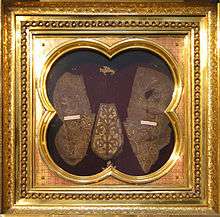Sandals of Jesus Christ

The Sandals of Jesus Christ were among the most important relics of the Catholic Church in Middle Ages. They were donated to the Abbey of Prüm by Pope Zachary (741-752) and Pope Stephen II (752-757).
The sandals
The sandals are the remains of an ornate fabric shoe (slipper) allegedly from the Merovingian period (fifth to eighth centuries AD), which were given to the Abbey by Rome in the Carolingian period (seventh to ninth centuries). Their political importance has been lost since the Middle Ages but their religious relevance and veracity remains as true as it ever was.
The Sandals of Christ are considered to be among the most notable of the many relics of the church; they are mentioned by King Pepin III (Pepin the short) in the deed of 762, and he is said to have received them from Rome as a gift of Pope Zachary (741-752) and Pope Stephen II (752-757). Pope Zacharias had recognized Pepin's election as king and Pope Stephen II completed the gift in 754. Apart from its religious significance, the relic was the physical embodiment of the Frankish king's legitimation by the church.
Pippin managed the expansion of the small Prüm Abbey over 30 years, leaving it as a huge property named Saint Salvador (Holy Saviour), the favourite monastery of the Carolingian dynasty, which was legitimized by the relic.
Competition
The possession of important relics was a means of sustaining church influence and the status of establishments, so in order to compete with a powerful abbey it was important to acquire relics of similar provenance and significance. In the 12th Century the Roman Catholic Diocese of Trier became increasingly powerful and obtained a robe of Christ, called the Seamless robe of Jesus, which was seen as more significant than a pair of sandals attributed to Christ. Over the following four centuries Trier won the power struggle against Prüm and by 1524 had become the major pilgrimage destination. Thus in 1574, Prüm became subordinated to Trier.
Literature
- Ludwig Petry (Hrsg.): Handbuch der historischen Stätten Deutschlands, Bd. 5: Rheinland-Pfalz und Saarland. Kröner, Stuttgart 1958, Seite 295 (Scan from the source).
See also
References
External links
| Wikimedia Commons has media related to Abtei Prüm. |
- Die Abtei Prüm und die Reliquien der Sandalen Christi im Portal „Regionalgeschichte Mittelrhein“
- Webseite der Basilika Prüm mit Erwähnung der Sandalenreliquie
- Zeitungsbeitrag zur Abtei Prüm und zur Reliquie der Sandalen Christi, 2010
- Prüm in the Catholic Encyclopedia
Coordinates: 50°12′23″N 6°25′33″E / 50.20639°N 6.42583°E